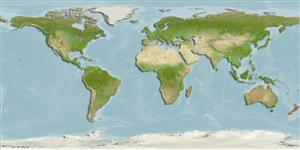Common names from other countries
>
Blenniiformes (Blennies) >
Tripterygiidae (Triplefin blennies) > Tripterygiinae
Etymology: Bellapiscis: Latin, bellum = war + Latin, piscis = fish.
More on author: Günther.
Environment: milieu / climate zone / depth range / distribution range
экология
морской демерсальный; немигрирующий; пределы глубины 0 - 5 m (Ref. 9003). Temperate
Southwest Pacific: endemic to New Zealand.
Size / Вес / Возраст
Maturity: Lm ? range ? - ? cm
Max length : 7.5 cm SL самец/пол неопределен; (Ref. 9003)
Краткое описание
определительные ключи | морфология | морфометрия
колючие лучи спинного плавника (общее число) : 18 - 21; членистые (мягкие) лучи спинного плавника (общее число) : 10 - 14; колючие лучи анального плавника: 2; членистые (мягкие) лучи анального плавника: 20 - 23.
Facultative air-breathing (Ref. 126274); Adults occur in rock pools and surge zones. They may remain out of water under rocks or seaweed (Ref. 31184). They feed on mollusks and minute crustaceans, including barnacles. This agile species eludes predators by alternately remaining motionless, then rapidly darting to a new location. Feeding occurs even in the swash zone where the fish rapidly darts with the surge and clinging to the rock as the water recedes, often being left exposed on the damp open rock (Ref. 26966). Eggs are hemispherical and covered with numerous sticky threads that anchor them in the algae on the nesting sites (Ref. 240). Larvae are planktonic which occur primarily in shallow, nearshore waters (Ref. 94114). They breathe air when out of water (Ref. 31184).
Life cycle and mating behavior
Maturities | размножение | Spawnings | Egg(s) | Fecundities | личинки
Eggs are deposited over the undersurface of a rock where they are fertilized and guarded by the male (Ref. 9003).
Fricke, R., 1994. Tripterygiid fishes of Australia, New Zealand and the southwest Pacific Ocean (Teleostei). Theses Zool. 24:1-585. (Ref. 13227)
Статус Красного Списка МСОП (Ref. 130435)
CITES (Ref. 128078)
Not Evaluated
Угроза для людей
Harmless
Использование человеком
рыболовство: интереса не представляет
дополнительная информация
инструменты
Специальные отчеты
Скачать в формате XML
ресурсы в Интернет
Estimates based on models
Preferred temperature (Ref.
115969): 12.8 - 18.7, mean 16.1 (based on 114 cells).
Phylogenetic diversity index (Ref.
82804): PD
50 = 0.7500 [Uniqueness, from 0.5 = low to 2.0 = high].
Bayesian length-weight: a=0.00794 (0.00346 - 0.01822), b=3.08 (2.88 - 3.28), in cm Total Length, based on LWR estimates for this (Sub)family-body shape (Ref.
93245).
Trophic level (Ref.
69278): 3.5 ±0.4 se; based on diet studies.
устойчивость к внешним воздействиям (Ref.
120179): высокий, минимальное время удвоения популяции до 15 месяцев (Preliminary K or Fecundity.).
Fishing Vulnerability (Ref.
59153): Low vulnerability (10 of 100).
